- Hotline: 852+ 2891 9689
- Whatsapp: 852+ 9146 8426
- [email protected]
- 6/F 29 Austin Road, Tsimshatsui, Kowloon, Hong Kong
Hair loss on the crown ( also known as the vertex ) is one of the most common patterns of male androgenetic alopecia. It’s primarily driven by genetics and the hormone dihydrotestosterone ( DHT ), which gradually miniaturizes hair follicles in this region.
But crown balding isn’t just a cosmetic issue — studies have shown a possible link between vertex baldness and cardiovascular disease. Research suggests that men with significant hair loss at the crown may have a higher risk of coronary heart disease, especially if the balding starts early.
One notable physical sign that may correlate with this risk is a crease in the earlobe ( called Frank’s sign ). While not definitive, the presence of this diagonal crease has been associated with atherosclerosis in several studies, and when seen in men with crown baldness, it may point to underlying vascular issues.
Crown ( vertex ) thinning is a common complaint in male pattern baldness, but not every man with hair loss in this area is a good candidate for transplant. Here’s a breakdown:
Men with:
Stable hair loss (not rapidly progressing)
Defined bald spot on the crown (not diffuse thinning)
Good donor density at the back and sides of the scalp
Realistic expectations (understand that 100% density may not be achievable)
Willingness to undergo maintenance therapy (e.g. finasteride) to prevent further loss around the transplanted area
Crown transplants can be rewarding in the right patient. Even moderate improvement in coverage can make a significant cosmetic difference, especially under overhead lighting.
Men with:
Extensive thinning across the entire top of the scalp, especially with poor donor supply
Unstable or rapidly progressing hair loss
Very fine hair and low follicular density in donor area
Unrealistic expectations, such as wanting full coverage with limited grafts
Reluctance to use maintenance medication — risking a “halo effect” where transplanted hair sits in a sea of thinning native hair
Remember:
To improve coverage and visual density in the crown or thinning top area.
Restore natural whorl pattern when possible.
Prioritize strategic placement of grafts to maximize the visual impact of each follicle.
Preserve donor supply for future needs and frontal restoration if required.
Ideal candidates include:
Men with Norwood Class III Vertex, IV, V, or higher, with clearly defined crown bald spot.
Patients with stable hair loss and good donor density.
Those who understand the limited density achievable in the crown and have realistic expectations.
Men willing to commit to long-term medical therapy to stabilize further hair loss.
Poor candidates include:
Men with diffuse thinning over the entire scalp, especially if donor is weak.
Those with unrealistic goals (e.g., full crown coverage in one session).
Patients with early-stage hair loss or unstable progression.
Surgical Tips
Though the crown is not part of the frontal hairline, recreating the natural spiral (whorl) pattern is essential for realism.
Frontal-midscalp priority must be respected — do not deplete donor for crown in younger patients.
FUE is the preferred method for crown work due to the small area and the need to extract selectively based on hair caliber..
FUT may be used in larger cases if donor density is good and multiple sessions anticipated.

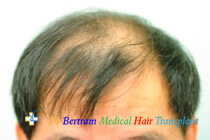
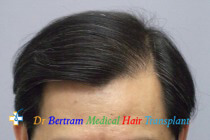
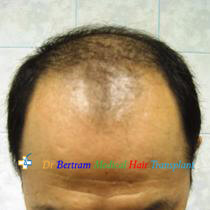
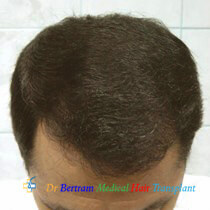
Losing hair in area 1 to 5 / 5v – usually not enough donor hair to cover the entire area. There are 2 options:
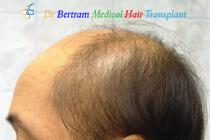
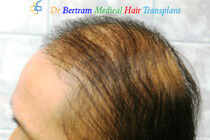
Losing hair in area 1 to 5 / 5v – usually not enough donor hair to cover the entire area. There are 2 options:
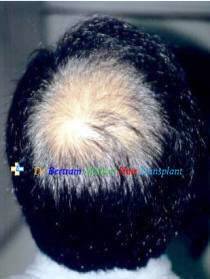
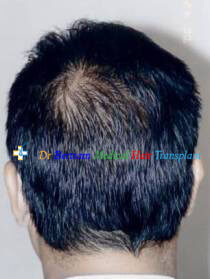
Shock loss refers to the temporary shedding of native hair following a hair transplant procedure. While it’s more frequently observed in women due to widespread miniaturization from Female Pattern Hair Loss (FPHL), shock loss can still occur in men — though it’s less common.
Shock loss is typically triggered by surgical trauma or stress to the scalp. Even when carefully performed, the procedure can temporarily disturb surrounding native hairs, especially if those hairs are already weakened due to:
Genetic miniaturization ( male pattern baldness )
Scalp inflammation or poor circulation
Nutritional deficiency or chronic stress
Onset: Typically 2–4 weeks post-transplant
Recovery: New growth generally begins around 3–4 months
Full regrowth: Usually achieved by 6–12 months
Most of the shed hairs return, often healthier and stronger with proper care and recovery support.
At our clinic, we take every precaution to reduce the chance and impact of shock loss:
Gentle and precise implantation to minimize trauma
Avoiding overpacking grafts into fragile native zones
Offering LLLT (Low-Level Laser Therapy) to enhance recovery
Advising targeted supplements and optional pre-op minoxidil for borderline areas
In most male patients, no. Shock loss is a temporary phase in the healing process.
However, if the affected hairs were already severely miniaturized, they may not return — not because of the transplant, but because they were nearing the end of their life cycle.

While not every man with crown thinning is at risk, it’s a good reminder to check blood pressure, cholesterol, and family history—especially if early crown balding is present.

From consultation, surgery, to aftercare, you will receive continued personal care by our doctors, not just consultants.
Have a question? Please feel free to call our friendly customer service.
International Accreditations
Recognized by leading global medical bodies, our clinic stands as one of the most qualified and internationally accredited hair transplant centers in Hong Kong and mainland China. We are proud to uphold the highest standards in medical ethics, safety, and surgical expertise.
Hair transplant is the ultimate solution to restores hair, but not everyone is good candidate.
Our online assessment helps determine if these procedures suit you, saving you time and costs.